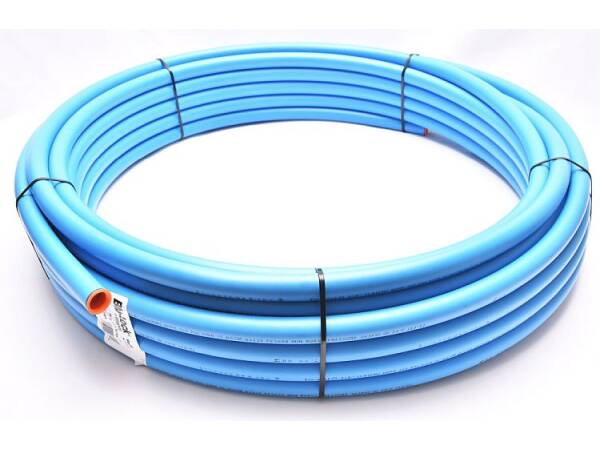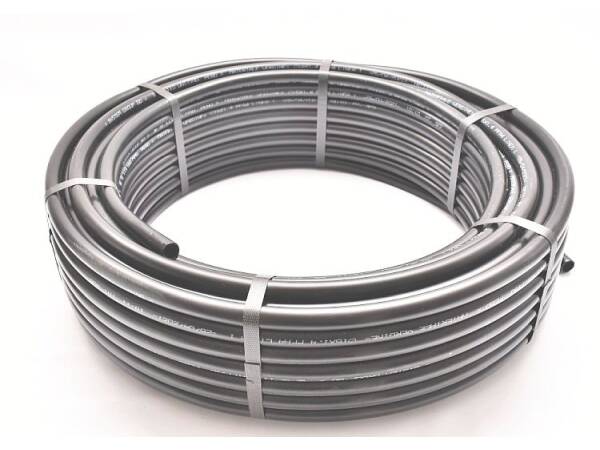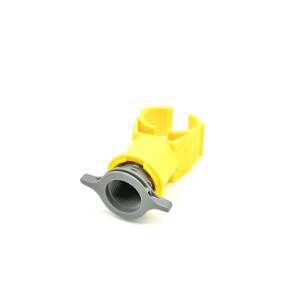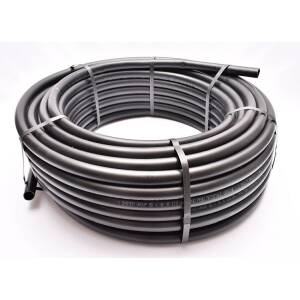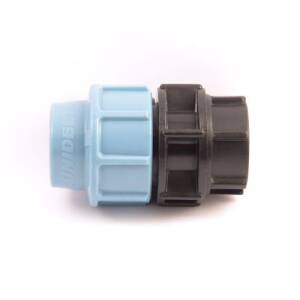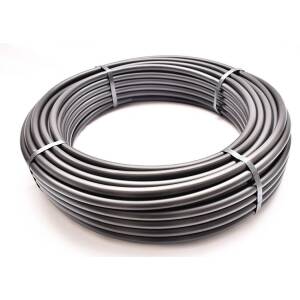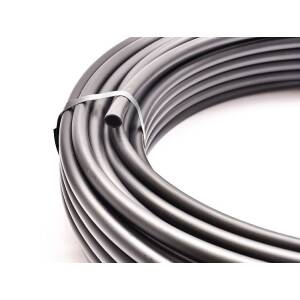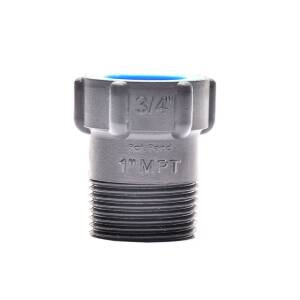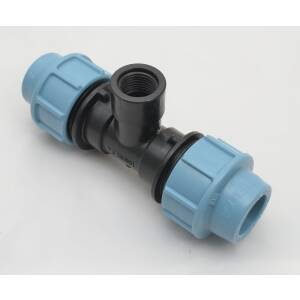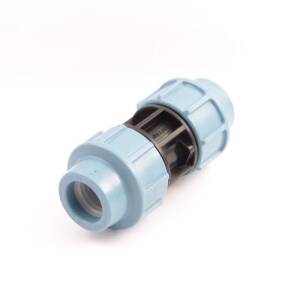Frequently Asked Questions (FAQs)
PE pipes are flexible, robust and corrosion resistant. They are easy to lay and are suitable for both above-ground and underground installations. Their UV resistance ensures a long service life. Thanks to a range of different diameters, you can optimally adjust the water flow. They are cost-effective and easy to connect with compression fittings.
PE pipes are available in different dimensions, typically with diameters from 16 mm to 50 mm. For smaller gardens and drip irrigation systems, PE 20 mm pipes are sufficient, while larger systems require PE 25 mm or 32 mm pipes. SDR classes provide information about the wall thickness and pressure resistance of the material. SDR 11 or SDR 17 is often used in drinking water supply systems because it offers high resistance to pressure fluctuations.
Compression fittings allow for easy connection of PE pipes without special tools. They consist of a cap nut, a clamping ring and a sealing ring. When the nut is tightened, the sealing ring is pressed against the pipe, creating a tight connection. This technique ensures stability and prevents leaks. They are ideal for DIY projects. Pipe clamp couplings made of stainless steel provide additional stability and are corrosion-resistant, making them particularly durable. This type of connection is also easy to clean and is suitable for flexible and modular systems.
Pipe fittings enable the permanent connection of PE pipes, while compression fittings are flexible and easy to assemble. Clamp connectors consist of a clamping ring, a cap nut and a seal that ensure a watertight connection. Stainless steel pipe connectors are particularly robust and suitable for high pressures. PE fittings with a thread or the Blu-Lock push-fit system are a simple solution for garden irrigation.
Yes, PE pipes are ideal for DIYers. By using clamp connectors, assembly can be done without special tools. It is important to plan the pipe route well. After laying, all connections should be checked for leaks. When laying underground, a minimum depth of 30 cm is required to protect against damage. Alternatively, threaded PE fittings can be used for a secure connection.
PE pipes come in different types, including PE 80, PE 100 and PE-HD. PE 100 has a particularly high pressure resistance and is suitable for long-lasting installations. HDPE (high-density polyethylene) offers high UV resistance and is ideal for above-ground installation. LDPE (low-density polyethylene) is more flexible, but less pressure-resistant and therefore more suitable for drip irrigation. Choosing the right type of PE depends on the specific requirements of your irrigation system.
The SDR class indicates the ratio of the outer diameter to the wall thickness of a PE pipe. The lower the SDR value, the thicker the pipe wall and the more pressure-resistant the pipe. SDR 11 or SDR 17 are most commonly used for garden irrigation because they offer a good balance between flexibility and pressure resistance. SDR 17 is particularly suitable for long lines with low pressure loss. It is important to choose the right SDR class for the specific application to ensure a long-lasting and efficient water supply. The wall thickness of the pipe plays a crucial role in the pressure resistance and safety of the system.
PE pipes are suitable for a wide range of temperatures. HDPE is more resistant to high temperatures, while LDPE is more flexible but more sensitive to heat. The maximum operating temperature for PE pipes is around 60°C, which is sufficient for most applications. For winter operation, it is advisable to lay the pipes at a frost-protected depth.
Planning and product selection – which PE pipes are the right ones?
The right choice of PE pipes and clamp connectors is crucial for the efficiency of your garden irrigation. PE pipes are available in different diameters and enable a demand-oriented water supply. Choosing the right pressure class is equally important: in most cases, PE pipes with a pressure resistance of 6 bar are sufficient. Clamp connectors enable quick and tight connection of the pipes. Alternatively, DVS Beregnung offers the Blu-Lock push-fit system, which makes installation even easier. The Plug&Rain® modular system ensures that you need fewer individual parts and minimize sources of error. With the DVS irrigation planner, you can put together your own individual irrigation system and ensure that all components are compatible. For certain items, a request must be made to receive an offer.
Material properties of PE pipes – Why they are ideal for irrigation
PE pipes are made of polyethylene, a durable and resistant material. This thermoplastic is particularly resistant to chemicals such as acids, salt solutions and alkalis, as well as to mechanical loads. HDPE pipes are characterized by their high durability and are suitable for pressurized systems. Due to their smooth molded parts, PE pipes have a low flow resistance, which makes them efficient at transporting water.
Advantages of PE pipes
PE pipes offer a variety of advantages over other materials. They are lightweight, inexpensive, and relatively easy to lay. In addition, PE pipes are UV-stable and impact-resistant, making them ideal for outdoor use. They are also corrosion-resistant and can be used without problems in contact with ozone, chlorine and salt water. PE pipes are also suitable for transporting drinking water and can be used as both pressure and suction pipes.
Installation and operation – tips for long-lasting irrigation
The installation of PE pipes is straightforward and requires no special tools. Follow these steps:
- Planning: Determine the pipe route and select the correct length of pipe.
- Cutting: Use pipe shears or a saw to cut the PE pipes to the desired length.
- Joining: Depending on the system, use compression fittings or the Blu-Lock push-fit system.
- Pressure test: Check the leak-tightness of all connections before use.
With well-thought-out installation and high-quality components, your irrigation will work efficiently and reliably.
Cutting, bending and connecting PE pipes
PE pipes can be cut, bent and connected in various ways. For cutting, pipe cutters or saws are suitable for clean and precise cuts. When bending PE pipes, a hot air gun or hair dryer can be used to achieve the desired shape. For connecting PE pipes, compression fittings or weld fittings are available. It is important to use the right tools and techniques to ensure a secure and durable connection. Careful workmanship ensures that the irrigation system remains reliable and leak-proof.
Pipe fittings and clamp fittings
Pipe fittings and clamp fittings are important components when laying PE pipes. They enable the construction of flexible and modular structures and devices. There are various types of pipe fittings and clamp fittings, such as cross clamp fittings, flange clamp fittings and foot clamp fittings. These connectors are made of materials such as plastic, aluminum or stainless steel, offering high corrosion resistance and easy cleaning. Choosing the right connector depends on the specific irrigation system requirements. High-quality pipe connectors and clamp connectors ensure a stable and tight connection that can withstand the demands of gardening.
 Free Online Irrigation-Planner
Free Online Irrigation-Planner



